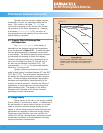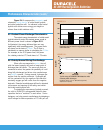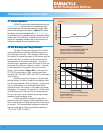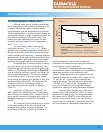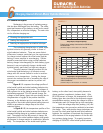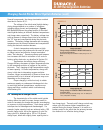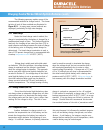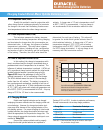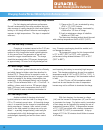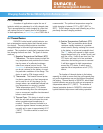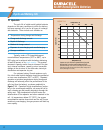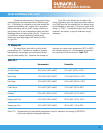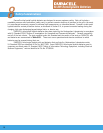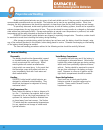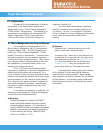
7.2 Battery Life
Table 7.2.1
Recommended Permissible
Low Rate Charge 15°C to 30°C (59°F to 86°F) 0°C to 45°C (32°F to 113°F)
Quick Charge 10°C to 30°C (50°F to 86°F) 10°C to 45°C (50°F to 113°F)
Fast Charge 10°C to 30°C (50°F to 86°F) 10°C to 45°C (50°F to 113°F)
Trickle Charge 10°C to 30°C (50°F to 86°F) 10°C to 35°C (50°F to 95°F)
Discharge 0°C to 40°C (32°F to 104°F) - 20°C to 50°C (-4°F to 122°F)
Storage, Short Term 10°C to 30°C (50°F to 86°F) - 20°C to 50°C (-4°F to 122°F)
Storage, Long Term 10°C to 30°C (50°F to 86°F) - 20°C to 35°C (-4°F to 95°F)
Table 7.2.1 Recommended and permissible temperature limits for operation and storage of DURACELL
nickel-metal hydride rechargeable batteries
.
18
Ni-MH Rechargeable Batteries
Charge rate and amount of charge input during
overcharging are also important factors affecting cycle
life. If the battery is charged at a rate that exceeds the
oxygen recombination rate, oxygen that is generated
during overcharge will not react, causing a build up in
gas pressure and a rise in temperature which will have
damaging effects on battery and cycle life. Prompt use
of an effective charge termination method when
deleterious overcharge begins will lessen the effect
on cycle life.
Cycle life is also affected by the depth of dis-
charge. Depending upon the charge termination method,
up to 500 cycles can be obtained with the battery being
fully discharged on each cycle (100 percent depth of dis-
charge, or “DOD”). Considerably higher cycle life can be
obtained if the battery is cycled at shallower charge/
discharges.
The same factors that affect cycle life affect
overall battery life. Operation or storage at extreme
temperatures, overcharging, cell venting and abusive
use will reduce battery life. Operation and storage of
batteries at or about room temperature (20°C or 68°F)
will maximize battery life. Recommended and permissi-
ble temperature limits are shown in Table 7.2.1.
Cycle and Battery Life (cont.)



